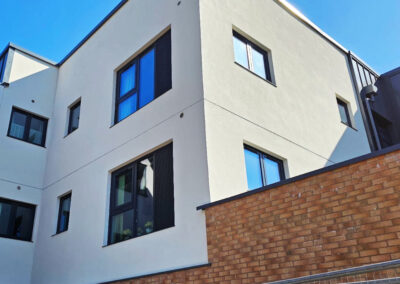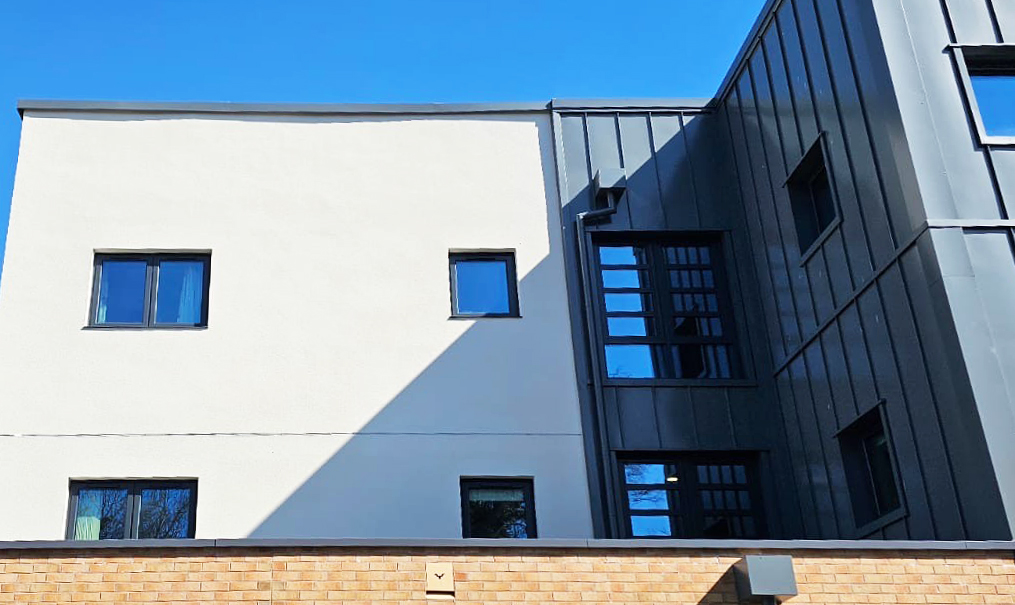INCA Case Study: Llys Awelon Extra Care Facility, Ruthin
Llys Awelon Extra Care Facility, Ruthin
Project Type: New Build
Building Type: Low Rise, Residential
Architect: Ainsley Gommon Architects
System Designer: Saint-Gobain Weber
Installer: Lock and Jones Plastering
System & Finish: webertherm XM: MFD + silicone render
U-Value Before: N/A
U-Value After: 0.18W/m²K
Project Detail
EXTERNAL WALL INSULATION IMPROVES COMFORT FOR OLDER PEOPLE’S EXTRA CARE SCHEME
The UK’s population is ageing, and results from the 2021 Census show the number of people aged 65 years and over in England and Wales increased from 9.2 million in 2011 to over 11 million in 2021. This is only expected to continue rising.
One of the challenges this presents is in housing – particularly housing with extra care schemes that enable people to receive the care and attention they need in later life, while maintaining their independence.
Llys Awelon in Ruthin, Wales offers exactly that. Developed in 2012 by Grwp Cynefin in partnership with Denbighshire County Council, the scheme provides housing, support and care services for people aged 55 and over.
There is a real sense of community spirit as it offers older people the very best of independent modern living in comfortable and safe surroundings.
A NEW ERA
In 2020, planning permission was granted for phase two of Llys Awelon to transform it into a modern, low-carbon bespoke scheme to better meet the needs of older people in the Denbighshire area.
“As a collaboration between Grŵp Cynefin, Denbighshire Council and the Welsh Government, Llys Awelon will provide the highest standard of extra care housing for the local community,” said Arwyn Evans, Head of Development at Grŵp Cynefin.
The £12.2 million redevelopment is supported by £7.1 million in funding from the Welsh Government Social Housing Programme. It involves the demolition of the existing Awelon Care Centre and Canolfan Awelon and the construction of the new facilities linked to the block of 17 existing extra care apartments which were completed in 2008.
The new three-storey extension consists of 17 one-bedroom and 18 two-bedroom self-contained apartments. It provides a mix of affordable homes for older people – including those with supported living needs – within a purpose-built facility with communal gardens, lounges, a restaurant, and a hairdressing salon.
This redevelopment also benefits the wider community with a grant fund of £18,000 as part of the contract with the construction company Read Construction. The Llys Awelon Community Grant has been distributed among local projects and clubs to improve lives and opportunities in the Ruthin area.
SUSTAINABLE DEVELOPMENT
It was important for the new residential building, which lies within the Ruthin Town and Llanfwrog Conservation Area, to be as sustainable as possible to futureproof it for generations to come.
It’s for that reason that local company Read Construction was selected as the main contractor for this project. The company’s management approach is based on the modern, lean and sustainable construction principles of delivering right first time to achieve client objectives and deliver defect-free facilities, with zero harm.
Arwyn added: “We’re working closely with Read Construction to implement innovative construction methods utilising eco-friendly materials and technology. The project is a great example of Grŵp Cynefin’s ability to bring partners together to deliver ambitious schemes for the benefit of our communities.”
The team from Read Construction worked with Ainsley Gommon Architects – a leading chartered practice of architects and urban designers with a focus on housing, education, healthcare projects and regeneration. The team is experienced at specifying similar projects in north Wales.
Locally sourced materials were used wherever possible, and the building has achieved BREEAM ‘Excellent’ status.
Arwyn Lloyd, associate director for Ainsley Gommon Architects, opted for a palette of natural materials to reflect the colour palette of the town and existing buildings. As such, the external materials include brickwork with a colour and texture that is in keeping with the adjacent buildings within the conservation area, as well as white render and areas of metal cladding.
OPTIMUM THERMAL EFFICIENCY
As part of the sustainability considerations, an external wall insulation (EWI) system was specified to maximise the thermal efficiency of the building.
For this, Darren Lock from Lock and Jones Plastering was selected as the applicator and he recommended Saint-Gobain Weber’s webertherm XM.
Ombler Williams had been contracted to install a steel frame system, to which Darren fitted the EWI. Using a light gauge steel frame with an EWI system not only maximises the internal space, but also speeds up the build process and increases the thermal efficiency of the wall.
The Weber system was applied to heavy duty concrete particle board fixed to the lightweight steel structure and 110mm of webertherm MFD – a non-combustible mineral fibre wool insulation – was used, offering a U-value of 0.18 W/m²K.
Two passes of weberend LAC rapid render were applied to the insulation, encapsulating the meshcloth reinforcement to resist structural movement. It was completed using webersil TF in Silver Pearl to provide an even textured finish. Being highly vapour permeable and UV stable with an enhanced water-resistant finish (W3), the silicone thin coat render provides optimum façade protection with low susceptibility to soiling.
MAXIMISING COMFORT
Being older, the residents of Llys Awelon are more vulnerable to the effects of poor insulation. Therefore, the installation of EWI will ensure their homes feel much warmer in winter and cooler in the summer. The refurbishment and extension work was completed in June 2024, meaning residents will first feel the benefits throughout the remainder of the warmer months before the winter sets in.
It will improve comfort for them not only by better regulating the temperature but also by improving air quality; EWI plays a big role in keeping out external pollutants and mitigating damp and mould. Not to mention the fact that, as energy prices remain high, having the extra insulation will help to reduce heating bills.
The EWI will improve comfort for residents not only by better regulating the temperature but also by improving air quality; EWI plays a big role in keeping out external pollutants and mitigating damp and mould.








